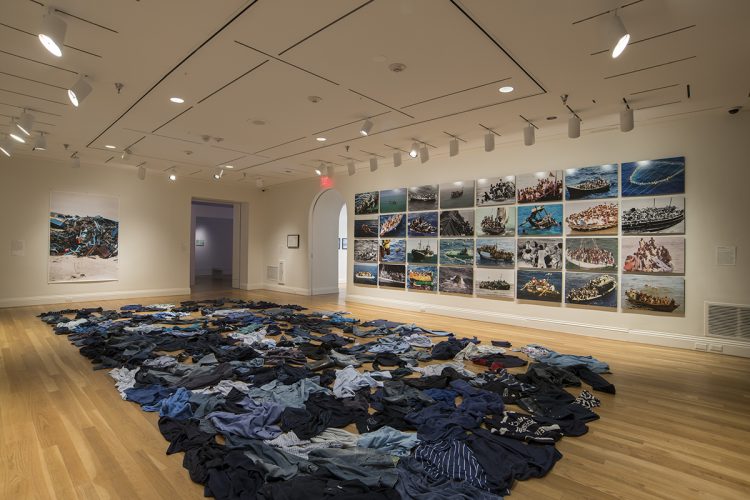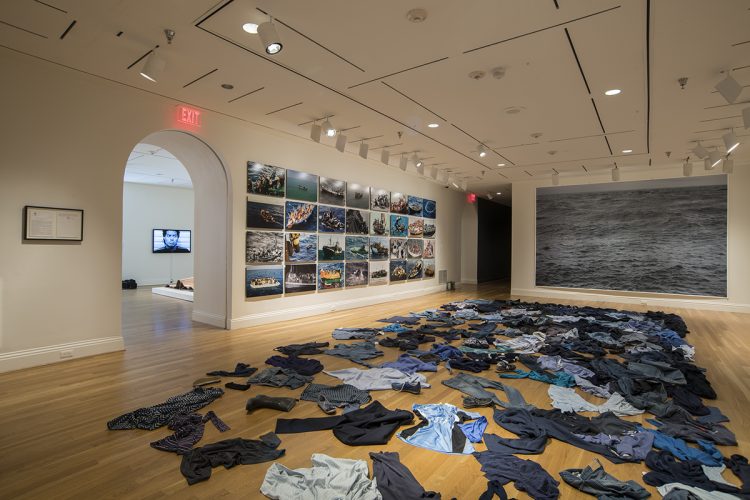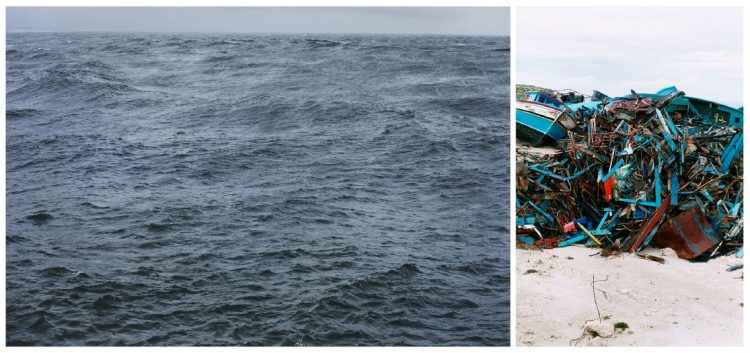Like the mythic landscapes of the American west, the sea represents a vast and indeterminate site of possibility. For the migrants who venture to cross the Mediterranean in their passage to Europe, the sea is a frontier marked by fear and the unknown. Since 2014, over 18,000 refugees have lost their lives attempting to cross the Mediterranean. Many artists featured in The Warmth of Other Suns: Stories of Displacement address the sea in their work. On the third floor of the exhibition, a gallery featuring the work of Kader Attia, Wolfgang Tillmans, and Xaviera Simmons provides a compelling narrative about the unknown.

The Warmth of Other Suns installation view with Kader Attia, La Mer Morte (The Dead Sea), 2015, Floor installation of second-hand clothing, Courtesy of the artist and Lehmann Maupin, New York, Hong Kong, and Seoul and Xaviera Simmons, Superunknown (Alive in the), 2010, C-prints mounted on Sintra, Collection Leslie and Greg Ferrero, Miami, courtesy David Castillo Gallery; Wolfgang Tillmans, Lampedusa, 2008, Inkjet prints on paper and clips, Courtesy of the artist and David Zwirner, Galerie Bucholz, Berlin/Cologne, and Maureen Paley, London. Photo: Lee Stalsworth

The Warmth of Other Suns installation view with Wolfgang Tillmans, The State We’re In, 2015, Inkjet prints on paper and clips, Courtesy of the artist and David Zwirner, Galerie Bucholz, Berlin/Cologne, and Maureen Paley, London. Photo: Lee Stalsworth
The sea appears as a site of bereavement in La Mer Morte (The Dead Sea) by Kader Attia (1970, Dugny, France; lives in Berlin, Germany, and Paris, France), which presents a spectrum of blue sweatshirts, denim, t-shirts, and shoes strewn across the gallery floor, as if the wearers had suddenly vanished. The colors mirror the shades and colors of the ocean, but Attia’s tableau makes visible what is absent: the human bodies that these garments were made to clothe. In this sense, the scattered clothing parallels the Mediterranean as a void where people disappear and calls attention to the migrants whose deaths at sea remain unreported because their bodies are never found. La Mer Morte offers both a poignant reminder of the loss of human life and a visual testimony to everyday tragedies.
Superunknown (Alive in the) by Xaviera Simmons (1974, New York City, USA; lives in New York City, USA), a grid of found photographs of overcrowded migrant boats, uses serial images of the European refugee crisis to study the sea as a site of contemporary migration. In the process of gathering images from magazines and newspapers, Simmons, a descendant of Black American slaves, European American colonizers, and early Indigenous Americans, considers the experiences of those who have left their homes to journey to the unknown—a notion emphasized in the work’s title. In the sea and outside the boundaries of nation states, both their survival and their status as citizens is profoundly beyond their knowledge and control.
In the photographs at opposite ends of the gallery, Wolfgang Tillmans (1968, Remscheid, Germany; lives in London, UK, and Berlin, Germany) offers two striking perspectives on the situation facing many migrants and immigrants. The State We’re In documents a part of the Atlantic Ocean where international time zones and borders intersect, and evokes the plight of migrants who journey by sea, venturing to cross a vast expanse where the borders of nation states disappear (and also leave migrant boats stranded as coast guards face off in their refusals of rescue). Lampedusa testifies in stark terms to the wreckage of migrant boats piled up on the tiny Italian island, whose proximity to North Africa puts it on the geographic frontline of the migrant crisis in the Mediterranean. These two images testify to the grim situation faced by migrants who risk their lives to seek entry to Europe by sea.

Wolfgang Tillmans, The State We’re In, 2015 (left), Lampedusa, 2008 (right)
Also in the gallery, is a copy of an open letter from the Mayor of Lampedusa Giusi Nicolini to the European Union from November 8, 2012, which begins: “I am the new mayor of the islands of Lampedusa and Linosa. I was elected in May, and by November 3, the bodies of twenty-one people who had drowned while attempting to reach Lampedusa had been consigned to me. I consider this totally unacceptable. For Lampedusa it is a terrible burden of grief. By way of the Prefecture, we have had to ask the mayors of the province for assistance just so that the last eleven corpses could be given a decent burial, because our municipal cemetery has no more room. We will make more space, but I have a question for all of you: how big does the cemetery on my island need to be?”
The Warmth of Other Suns: Stories of Global Displacement is on view through September 22.
